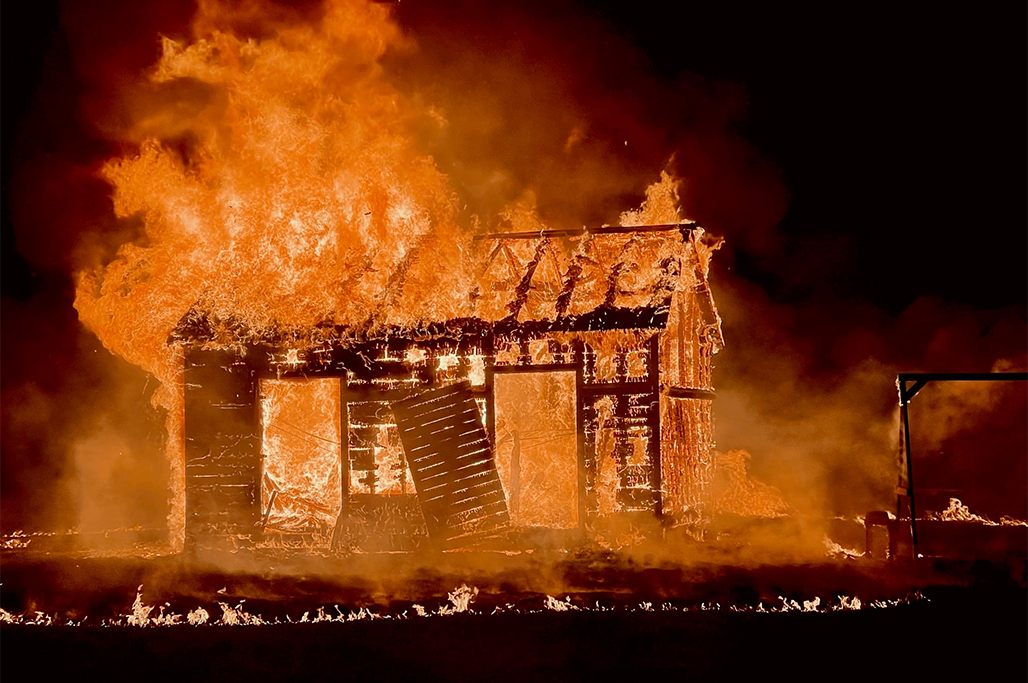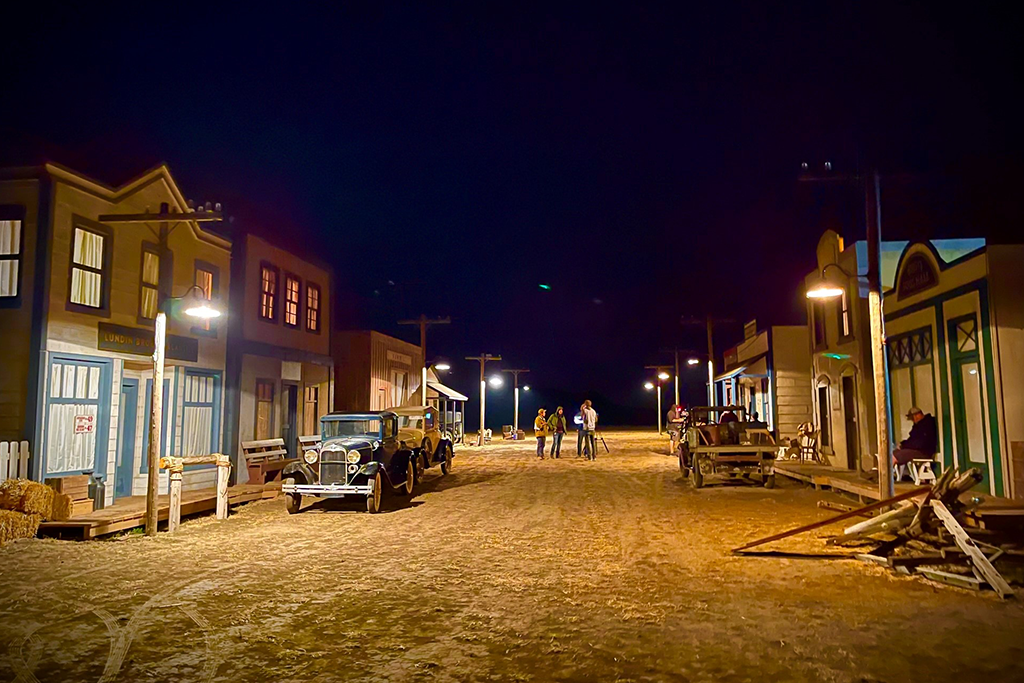Theatre Arts professor moves from stage to screen
UND Theatre’s Brad Reissig makes film debut with ‘End of the Rope’ premiering in Chester Fritz Auditorium on April 1

Nearly three years ago, Brad Reissig received a call from the producer of a film called “End of the Rope,” a historical crime drama about the chaos caused by a notorious criminal in Schafer, N.D., in 1931.
A co-chair of the University of North Dakota Department of Theatre Arts, Reissig has honed his artistic skills in stagecraft and design for decades, but this was a first for him.
“The producer, Daniel Bielinski, likes to have local people working on these films. He was going through websites of all the local universities and companies and just kind of cold-called me,” said Reissig, who was initially surprised by the offer.
“End of the Rope,” produced by Canticle Productions, is centered on the infamous murderer and last person lynched in North Dakota, Charles Bannon. Reissig never had worked on a film until he received the producer’s call about being art director for the project.
“At first, I wasn’t sure what to think, but after I did some research, everything seemed legit. So, I called him back and told him I was definitely interested in the project,” Reissig recalled.
Shortly after production started, however, his role in the project changed. The person initially hired as production designer had to bow out. This left Reissig in the saddle, performing the duties in tandem as cast and crew set up shop in Watford City, N.D., where the project was being filmed.
Production design is an oft-overlooked part of filmmaking. While actors, directors and cinematographers are typically at the center of award-season campaigns and production updates, production designers play the vital role of getting the setting, costumes and props in the right visual wheelhouse.
Reissig recalled being initially apprehensive. Despite his long career in theater, film is a different beast.
“The thing you have to remember is that the audience watches theater in a fixed space, you’re only really worried about what they can see facing the stage,” Reissig explained. “In film, the camera can move 360 degrees. You can take the audience anywhere, so you have to keep that in mind. I was expecting some challenges.”
His first-film jitters didn’t last long, though; once the cameras started to roll for “End of the Rope,” he was feeling more than ready to tackle the production. With UND productions such as the ornate “Importance of Being Earnest” and the intimate “Rabbit Hole” showcasing his versatility and talent as a scenic designer, Reissig was well-positioned to translate his artistic sensibilities to the new medium.
“I was feeling pretty confident by the time I took over the design aspects,” he said. “I’d already done a lot of research for the film and realized I already had the skill set to get this done. The way my brain works with a theater script was similar to how I approached this film.”
Still, production design is a crucial element for a period film such as “End of the Rope.” Taking place in a specific moment and location in history, the film’s authenticity hinges on getting the little details just right. Something as inconsequential as the color of paint used on a building exterior can break an audience’s immersion, whether they’re conscious of it or not. Extensive research and imagination were required for Reissig to get the job done.
“Back then, everybody took pictures of their buildings when they were brand-new, and a lot of reference pictures we had to work with were just that,” Reissig explained. “We had to figure out what it would look like when it’s been out in the elements, getting beat up by rain and snow for 20 or 30 years. I’d say more than half of the work I did on this project was that kind of research, sketching things out to make it look realistic and lived-in.”

By the time Reissig had gotten his bearings, filming for the production officially had started, and he was overseeing the design process of a life-sized replica of Main Street in Schafer.
Reissig recalled seeing the town in its finished state and being impressed with how real it felt. In contrast to the built-in detachment of stage productions, films offer an expansive immersion, a real-world replica that is hard not to get caught up in, he said.
“One of the really cool things about working on a film like this is that you’re fully immersed in the setting,” he said. “We built a set of an entire small town; a whole street with houses, shops, banks. It was really exciting to be around that every day.”
Reissig notes that film, much like theater, often relies on authenticity to captivate an audience. Thankfully, the process of making “End of the Rope” lent itself to his artistic goals in a number of ways, not least of which was the environment the crew filmed in.
The crew’s filming location in Watford City, just 5 miles away from the site where the actual Bannon met his fate, was key to the film’s historicity. In addition to its physical proximity to the real-life locale, Watford City’s cultural and historical connection lives on in the area to this day.
Watford City locals eagerly offered stories of familial connections to Schafer’s history and allowed Reissig access to historical materials preserved from Bannon’s life. In addition to helping Reissig better understand how to design specific props and sets, it also deepened his experience working on the project.
“There are two really good historical museums in Watford City. One is kind of like an Old West town, and the other is more of a historical museum. They were both really generous in letting us borrow their stuff,” Reissig said.
“One of them had a whole section dedicated to the Bannon case. We had the opportunity to look at and use a lot of the actual artifacts for the film. To actually be able to look at and hold Bannon’s journals that he kept in jail, things like that stick with you. It made the work really fun.”

Reissig explained that Schafer was largely abandoned by the 1940s, partly due to the traumatic events that had occurred there during the Bannon saga. One of the few remnants of Schafer is the jailhouse building where Bannon lived his last days, and in which the film was able to use for a few scenes.
“This thing had been used as a granary for something like 50 years, so we had to put cell bars in and everything. But you really can’t beat having access to that. I just remember walking in and looking at the texture on the walls and thinking that it was just beautiful, it was exactly what I was looking for,” said Reissig.
Of course, it wouldn’t be a thriller without a little danger. Reissig recalled that one of the more thrilling moments of filming “End of the Rope” was burning a house down. They didn’t accomplish this with computer-generated imagery though; a local man offered up a building for them to burn down for real.
“You don’t really get to do things like that on stage, so it was exciting. We shot that scene four times. There was so much heat coming off the building, we had to stop to move the cameras back. It may have even melted a port-a-potty, but I won’t comment on that,” he joked.
While Reissig won’t see the finished product until its premiere in the Chester Fritz, he was pleased with the quality of the film’s trailer and the promotional material he’s seen so far. Finally, after nearly three years, he’s getting the opportunity to see his hard work in a finished state.
“I’m really excited to finally watch it. There’s so much that goes into a film, there’s a whole team of people who worked on post-production, things like visual effects and editing, whom I haven’t even met,” he said. “When we were filming, I saw everything under fluorescent lights — and until you see the finished product on screen, you don’t know how it’ll really look. Everything I’ve seen so far looks great, though.”

At present, Reissig is hard at work on UND’s upcoming production of “Conference of the Birds,” a play based on the writings of 12th century Persian poet Farid Ud-Din Attar that focuses on a group of birds on a spiritual journey to find God.
“It’s going to be really unique,” Reissig said. “The cast plays a group of birds — a peacock, a hoopoe, a hawk. They’ve all got different characteristics, costumes and personalities. So, I’m really excited for people to see it.”
If that weren’t enough, he’s already working on a set design for next season’s play “Wait Until Dark,” a classic thriller that was adapted from the 1967 film by the same name.
“We’ve just started the initial design process for that. Emily Cherry Oliver, the director, and I have started to finalize some of the design elements. Right now, I’m looking at a lot of 1960s apartments and figuring out how we’ll get everything we need into the black box theater downstairs,” he said with a laugh.
As for his future in working in film, Reissig already has been contacted by Canticle to work on some future productions.
“One of them sounds like it’ll be a sure thing,” he said, “I can’t really talk about it yet, but as soon as I got the script, my brain started racing and I was just captivated. I can’t wait to work with this group again, and this time there won’t be any hesitation.”
“End of the Rope,” produced by Canticle Productions and directed by Charles Griak, will premiere at 7 p.m. April 1 in the Chester Fritz Auditorium. A Q&A with the cast and crew will take place after the film.
Tickets to the event can be purchased here.
Watch for “Conference of the Birds” in the Burtness Theater in April.



